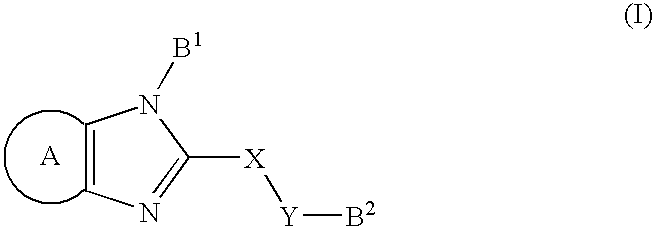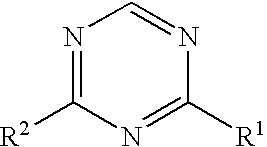Receptor Function Regulating Agent
a function regulating agent and receptor technology, applied in the field of gpr40 receptor function regulating agent, can solve the problem of not having a report documenting the function regulating effect of gpr40 receptor in known fused imidazole compounds, and achieve the effect of superior gpr40 receptor function regulating action
- Summary
- Abstract
- Description
- Claims
- Application Information
AI Technical Summary
Benefits of technology
Problems solved by technology
Method used
Image
Examples
reference example 1
Production of 5-chloro-N-(4-methoxyphenyl)-2-nitroaniline
[0415]
[0416] A mixture of 2,4-dichloronitrobenzene (6.2 g, 32.29 mmol), p-anisidine (3.98 g, 32.29 mmol) and potassium fluoride (1.88 g, 32.29 mmol) was stirred for 20 hr at 160° C. To the reaction mixture was added saturated aqueous sodium hydrogencarbonate, and the mixture was extracted twice with ethyl acetate. The organic layers were combined, washed with saturated brine, dried over magnesium sulfate and concentrated under reduced pressure.
[0417] The residue was purified by silica gel chromatography (eluent; ethyl acetate / hexane=1 / 10) and recrystallized from diethyl ether to give the title compound (5.5 g, yield 61%) as orange needle crystals.
[0418]1H-NMR (300 MHz, CDCl3) δ: 3.86 (3H, s), 6.66 (1H, dd, J=2.2, 9.2 Hz), 6.93-7.01 (3H, m), 7.18 (2H, d, J=8.8 Hz), 8.14 (1H, d, J=8.8 Hz), 9.44 (1H, brs)
[0419] melting point: 108-109° C.
reference example 2
4-Chloro-N2-(4-methoxyphenyl)benzene-1,2-diamine
[0420]
[0421] A solution of the compound (2.0 g, 7.18 mmol) of Reference Example 1 in THF (80 mL)-EtOH (40 mL) was added to an aqueous solution (100 mL) of sodium hydrosulfite (20.0 g, 114.88 mmol) under ice-cooling, and the mixture was stirred at room temperature for 1 hr. To the reaction mixture was added saturated aqueous sodium hydrogencarbonate, and the mixture was extracted twice with ethyl acetate. The organic layers were combined, washed with saturated brine, dried over magnesium sulfate and concentrated under reduced pressure to give the title compound (1.78 g, yield 100%) as a red oil.
[0422]1H-NMR (300 MHz, CDCl3) δ: 3.20-3.70 (3H, br), 3.76 (3H, s), 6.65 (1H, d, J=8.3 Hz), 6.78-6.84 (5H, m), 6.94 (1H, d, J=2.3 Hz).
reference example 3
6-Chloro-1-(4-methoxyphenyl)-1,3-dihydro-2H-benzimidazole-2-thione
[0423]
[0424] To a solution of the compound (1.78 g, 7.16 mmol) of Reference Example 2 in THF (100 mL) was added 1,1′-thiocarbonyldiimidazole (1.53 g, 8.58 mmol) under ice-cooling, and the mixture was stirred at room temperature for 18 hr. To the reaction mixture was added saturated aqueous sodium hydrogencarbonate, and the mixture was extracted twice with ethyl acetate. The organic layers were combined, washed with saturated brine, dried over magnesium sulfate and concentrated under reduced pressure to give a pale-brown solid. This solid was washed with a mixed solution of diethyl ether and hexane, and dried under reduced pressure to give the title compound (1.58 g, yield 77%) as a white powder.
[0425]1H-NMR (300 MHz, CDCl3) δ: 3.90 (3H, s), 6.93 (1H, d, J=2.4 Hz), 7.09-7.22 (4H, m), 7.40 (2H, d, J=8.9 Hz), 10.45-10.55 (1H, br).
PUM
| Property | Measurement | Unit |
|---|---|---|
| Electrical resistance | aaaaa | aaaaa |
Abstract
Description
Claims
Application Information
 Login to View More
Login to View More - R&D
- Intellectual Property
- Life Sciences
- Materials
- Tech Scout
- Unparalleled Data Quality
- Higher Quality Content
- 60% Fewer Hallucinations
Browse by: Latest US Patents, China's latest patents, Technical Efficacy Thesaurus, Application Domain, Technology Topic, Popular Technical Reports.
© 2025 PatSnap. All rights reserved.Legal|Privacy policy|Modern Slavery Act Transparency Statement|Sitemap|About US| Contact US: help@patsnap.com



